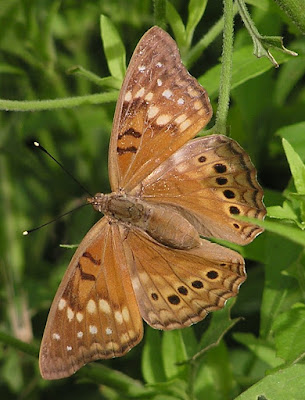The Lower Rio Grande
Valley (LRGV) isn’t just a hotbed of unique birds for the United States, but
for butterflies (and other critters) as well!
Just as birders flock to the Valley in hopes of seeing lifers and
rarities, the same holds true for butterfly watchers who come in search of
Mexican butterflies that reach the northern limits of their range here in south
Texas, but also in hopes of that rare stray that may wander across the border!
Good butterflying is
possible any time of year in the Valley, but normally the best time is October
and November, with January and February generally being the poorest. This year the butterflying was particularly
good in July, after we had gotten significant rainfall in June. Relatively large numbers of otherwise rare
species (like Banded Peacock and Polydamus Swallowtail) were showing up, and no
less than three Erato Heliconians (normally a mega-rarity) showed up
simultaneously at different locations!
Even now in mid-August (with 100-degree temperatures and no rain to
speak of), good butterflies are still showing up.
Banded Peacock, Bentsen Rio Grande SP
Polydamus Swallowtail, Estero Llano Grande SP
Erato Heliconian, Bentsen Rio Grande SP
There are many excellent
places to look for butterflies, my favorite being the National Butterfly Center
(NBC) in Mission: the gardens and native
habitats are extensive, and the new “experimental gardens” in the “back yard”
of the visitor center are attracting some great butterflies! Just recently we found Zilpa and
White-striped Longtails, Coyote Cloudywing, Mangrove Buckeye, Dingy Purplewing,
Many-banded Daggerwing, and Guatemalan Cracker among the more common Mexican
Bluewings, Tawny Emperors, and ever-present Queens and large sulphurs!
Coyote Cloudywing, NBC
Dingy Purplewing, NBC
Guatemalan Cracker, NBC
Zilpa Longtail, NBC
Large Orange Sulphur, Falcon SP
Many-banded Daggerwing, NBC
Mexican Bluewing, NBC
Queen, Edinburg Scenic Wetlands
Tawny Emperor, NBC
Tropical Buckeye, NBC
White-striped Longtail, NBC
Nearby Bentsen Rio Grande
State Park also has extensive butterfly gardens, not only near the visitor’s
center but also at the Nature Center and near Kingfisher Overlook. Over the years Bentsen has hosted many rarities
including Four-eyed Sailor, Ornythion Swallowtail, and Common Banner. Rare hairstreaks have included White and
Yojoa Scrub, Marius, Strophius, and even a super-rare Aquamarine! Many butterfliers will check out the
plantings along Bentsen Palm Drive near Retama Village; on one visit with
friends we found a rare Ruddy Hairstreak!
Common Banner, Bentsen SP
Four-eyed Sailor, Bentsen SP
Marius Hairstreak, Bentsen SP
Ornythion Swallowtail, Bentsen
Ruddy Hairstreak, Bentsen Palm Drive
White Scrub Hairstreak, Bentsen SP
If you want to head out
to Starr County looking for Red-billed Pigeon and White-collared Seedeater, the
butterfly garden at Falcon State Park is worth checking: some butterflies that prefer a drier climate
may be easier to find here, like Nysa Roadside Skipper and Desert Checkered
Skipper. Although they could potentially
show up anywhere, I’ve had several “one and onlies” at this garden, including
Curve-winged Metalmark, Lacey’s Scrub-Hairstreak, and Green-backed Rubyeye.
Desert Checkered Skipper, Falcon SP
Green-backed Rubyeye, Falcon SP
Nysa Roadside Skipper, Falcon SP
The coastal areas host a
handful of species not normally seen inland:
Resaca de la Palma State Park is famous for its Blue Metalmarks,
Band-celled Sisters, Orange-barred Sulphurs, and Boisduval’s Yellows! The Xami Hairstreak favors low-lying
succulents that can be found along Old Port Isabel Road and Boca Chica
Boulevard, and the Sabal Palm Sanctuary also has a butterfly garden where you
might find Double-dotted and Obscure Skippers.
Definite Patch has been found at the Palo Alto State Historic Site, and
the gardens near the visitor center at Laguna Atascosa can also have Blue
Metalmarks, along with more widespread species.
Band-celled Sister, Bentsen SP
Blue Metalmark, Resaca de la Palma SP
Boisduval's Yellow, Resaca de la Palma SP
Double-dotted Skipper, Sabal Palm Sanctuary
Obscure Skipper, South Padre Island
Orange-barred Sulphur, Resaca de la Palma SP
Other good butterfly
spots that I enjoy frequenting include the Old Hidalgo Pumphouse, where I once
had an Erato Heliconian, but also more expected specialties like Julia
Heliconian and Cyna Blue. Further north,
Edinburg Scenic Wetlands is a great little place with extensive gardens and can
be a good place to find the knock-out Guava Skipper. In Weslaco, both Estero Llano Grande State
Park and Frontera Audubon Thicket have excellent butterfly gardens; rarities
that have shown up at Estero include Mexican Silverspot and Dark Kite Swallowtail. Frontera is famous for being a rare bird
trap, but strays such as Tailed Aguna and the uncommon Teleus Longtail have
shown up here.
Cyna Blue, Old Hidalgo Pumphouse
Guava Skipper, Estero Llano Grande SP
Julia Heliconian, Old Hidalgo Pumphouse
Mexican Silverspot, Estero Llano Grande SP
Tailed Aguna, Frontera Audubon Thicket
Some of the other birding
hotspots are also good for butters, but require a little more walking; these
areas include Santa Ana NWR and the Yturrias Tract of the Lower Rio Grande
Valley NWR (although I would encourage taking a buddy if exploring this area,
as it is remote). The garden at 101 South 7th Place is part of Alamo Inn
B&B Gears and Tours; it has 107 species of butterflies and counting,
including specialties such as Polydamas Swallowtail and Theona
Checkerspot. We even had a super-rare Orion
Cecropia show up!
Theona Checkerspot, Falcon SP
Wherever you choose to
search for butterflies, never forget to appreciate even the common, widespread,
and beautiful lepidoptera that call the LRGV their home!


































This comment has been removed by the author.
ReplyDelete